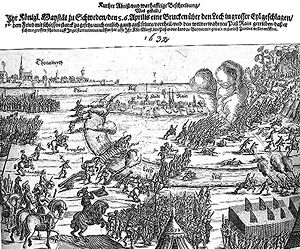Battle of Rain
|
Battle of Rain or Battle of Lech or Battle of the River Lech |
|||||||
|---|---|---|---|---|---|---|---|
| Part of the Thirty Years' War | |||||||
 |
|||||||
|
|||||||
| Belligerents | |||||||
|
|
|
||||||
| Commanders and leaders | |||||||
|
|
|
||||||
| Strength | |||||||
| 40,000 | 25,000 | ||||||
| Casualties and losses | |||||||
| 2,000 dead | 3,000 dead | ||||||
The Battle of Rain (also called the Battle of the River Lech or Battle of Lech) was fought on April 15, 1632, as part of the Thirty Years' War. The forces involved in this conflict were 40,000 Swedish troops under Gustavus Adolphus and 25,000 Catholic League troops under Johan Tserclaes, Count of Tilly. It was the second meeting between the two legendary generals (see First Breitenfeld when Tilly received the first setback of his long and storied career) and like at Breitenfeld, Tilly lost when Gustavus forced the River Lech under the cover of his superb artillery.
Gustavus had a bridge of boats constructed across the Lech river near the city of Rain through the night prior to the battle, and in the morning sent three hundred Finnish Hackapelite troops across the river under fire. The Hackapelites dug earthworks for batteries which then protected the rest of Gustavus' army as they crossed the river. As soon as his army had crossed the river, Gustavus immediately and successfully stormed the hill. Tilly was shot in the leg early in the battle and was moved to the rear; his second in command, Johann von Aldringen, was knocked unconscious with a skull fracture minutes later. Maximilian I, Elector of Bavaria, ordered an immediate retreat to save the now leaderless army, leaving most of the Catholic League's baggage and artillery in the field. The army itself may only have escaped destruction due to a storm and high winds blocking roads in the night that followed.
The immediate result of the battle was that Bavaria lay open for occupation by the Swedish army, enabling Gustavus Adolphus to temporarily threaten the Austrian heartland.
The battle is, however, more interesting from a tactical point of view rather than from its outcome, as the elaborate plan of Gustavus Adolphus to catch the entire Imperial army by complex maneuvering was prevented when Tilly was mortally wounded in the battle, resulting in the early retreat of the Imperial army. The Swedish battle plan consisted of two major elements:
...
Wikipedia
